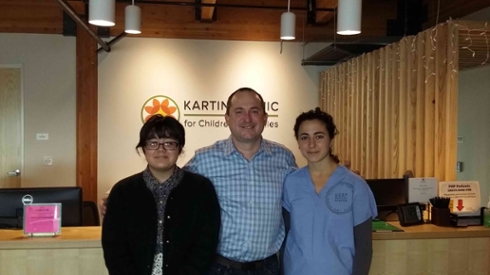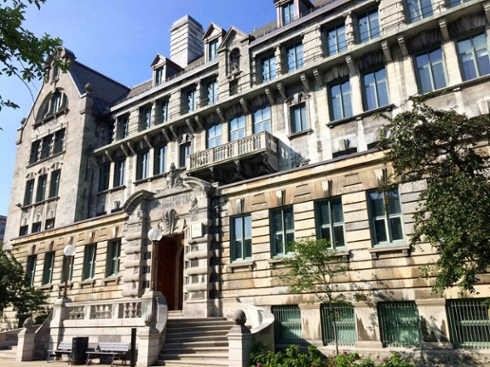Tags
"genetics"
Kartini Clinic for Pediatric Eating Disorders: Mitra Shokat, Winter Shadow 2016

Kartini Clinic is a small health clinic in Northeast Portland that offers treatment for pediatric patients with eating disorders. Kartini’s approach to eating disorder treatment differs in many ways from that of other facilities. The clinic’s treatment program is family-based and places an emphasis on eating disorders as genetic metabolic disorders instead of psychiatric disorders. In the past year, Kartini Clinic has even implemented individualized genetic testing as a part of their treatment process.
Upon intake, Kartini Clinic patients, ranging in age from 6 to 23 years old, are placed in one of the clinic’s three stages of treatment: the partial hospitalization program, the intensive outpatient program, or the outpatient program. During my two weeks shadowing one of the clinic’s medical assistants, I was given the chance to observe all three levels of treatment. However, I primarily interacted with patients in the partial hospitalization program, taking vitals each morning and occasionally eating meals with them. I learned some incredibly useful skills over the course of those two weeks, including how to take blood pressure manually, how to analyze urine samples, and how to recognize abnormal levels in certain vital measurements.
During my time at Kartini Clinic, I also conducted research. I was responsible for collecting data on the initial diagnoses and intake medications of one hundred of the clinic’s most severe patients. This data will later be compared to the results of genetic testing for those patients. This genetic testing, conducted by a company called Genomind, gives the doctors at Kartini Clinic information about specific mutations that are commonly associated with negative reactions to certain psychoactive drugs. This type of information is invaluable to the doctors, as they often prescribe psychoactive drugs to combat the anxiety and depression that often accompany eating disorders. The goal of our research is to observe any correlations between the results from this genetic testing and the severity of the patient.
Presidents Summer Fellowship, Nanofluids and Gene Mapping Part 3, Abrar Abidi

For his President's Summer Fellowship, Abrar Abidi ’16, physics major is working in a lab at McGill University in Canada, helping to develop new nanofluid technology to improve DNA mapping methods. Read on for his third and final blog installment:
Since leaving Montreal at the end of August, I’ve thought back many times to that day I walked through the old city and down to the port. There, in the Fleuve Saint-Laurent, which flows down to the Great Lakes, lies the small Île Sainte-Hélène. And on the other side of this island, half-concealed by a line of trees, is a structure that looks like it came from another planet. Two hundred feet high, and webbed with steel beams and acrylic panels in the shape of a globe, this exotic building disorients anyone that sees it. It is, of course, the Montreal Biosphere, built a half-century ago by Buckminster Fuller for Expo 67, the most successful world’s fair of the 20th century. In its time, when so many countries were riven by wars and paranoia, Expo 67 offered the world a brief remove from the painful past and shameful present—it offered what the world most craved: an optimistic vision for the future.
My grandfather, who died three years ago, was among the 50 million people who attended Expo 67. The son of a radio repairman in India, he grew up in modest circumstances and struggled to secure himself an education at the only university for Muslims in India. He rose, quickly, to the top of his class, and won a scholarship to come to the US where he began graduate studies in civil engineering at Harvard. Soon after his degree my grandfather returned to what was by then Pakistan, where six of his ten siblings shared two small, adjacent rooms. He worked intensely so he could support and provide a good education to his brothers and sisters. That generation of the Abidi family, though small in number now, all went on to find success in their individual careers, and passed on my grandfather’s tradition of hard work and education to the Abidis of my parents’ generation.
Presidents Summer Fellowship, Nanofluids and Gene Mapping Part 2, Abrar Abidi

For his President's Summer Fellowship, Abrar Abidi ’16, physics major is working in a lab at McGill University in Canada, helping to develop new nanofluid technology to improve DNA mapping methods. Read on for his second blog installment:
On so many warm summer evenings here, red and white flares shoot up on the horizon, hissing as they go, before exploding with a deafening pop, forming a lavish spectacle in the Montreal sky. Often as I sit in my little Victorian-era apartment, sudden bangs and crackles send me rushing out to the roof of my building, so I can look toward the harbor, where on an otherwise forlorn stretch of land, six thousand rockets now fire heavenward in a single night. Yearly, the largest firework festival in the world—a kind of pyrotechnic Olympics—takes place in Montreal throughout the month of July. Groups from countries across the world, with their eyes set on prestigious awards, collect in this city to show off their talents in front of three million people. This year, England won the gold medal, while France took home silver and China, bronze. All this amid a procession of other festivities celebrating jazz and African cultures and circus arts and film and comedy. On the few nights not occupied by these events (and we’re still talking only of July), there are huge live music shows, free to the public, many taking place a two-minute walk from my front door.
The lab is a far quieter and colder place. With vents constantly blowing dry, chilly air on every floor of the building, I’ve taken to swaddling myself in at least three layers. Fortunately, the work I do expunges all my guilt for staying indoors. The opportunity to participate in this lab’s experimental efforts is what lured me to McGill in the first place, and in the previous month, my project has taken on a more experimental flavor. Sara, a good friend and researcher with whom I’ve been working closely since June, gave me the task of analyzing thousands of fluorescence microscopy images, zoomed in so close that a fraction of the width of a single human hair could easily eclipse the viewfinder. Fluorescence microscopy is a remarkable technique, where special dyes are used to stain the object of interest, causing it, when illuminated by a powerful lamp, to cast a vivid, luminous glow, no less dazzling to the eyes than the firework displays I can sometimes see from the lab window. Our microscopes are trained on minuscule nano-devices that Sara very cleverly designed and fabricated. Below the glass cover slip, and within these tiny devices, anywhere from a few dozen to several hundred strands of DNA can be seen drifting here and there, tossed about by Brownian motion, flashing like fireflies in the night. Then, with the flip of a switch, the strands rush toward the centers of a series of equidistant spaces, where they accumulate and extend, resembling a phalanx poised for battle. A dial that controls the frequency of a current sent through the device can manipulate their movement, alternately dispersing and concentrating the DNA. The potential applications for this invention are dizzyingly exciting: nothing less than the technology future generations might use to map entire genomes, at speeds and with accuracies far beyond anything currently possible.
Presidents Summer Fellowship, Nanofluids and Gene Mapping, Abrar Abidi

For his President's Summer Fellowship, Abrar Abidi ’16, physics major is working in a lab at McGill University in Canada, helping to develop new nanofluid technology to improve DNA mapping methods.
A chemist who had close friendships with both Albert Einstein and Ernest Rutherford was once asked to share his recollections of the two men. In response, he explained:
“[Einstein] always spoke to me of Rutherford in the highest terms, calling him a second Newton. As scientists the two men were contrasting types—Einstein all calculation, Rutherford all experiment… There was no doubt that as an experimenter Rutherford was a genius, one of the greatest. He worked by intuition and everything he touched turned to gold. He had a sixth sense.”
